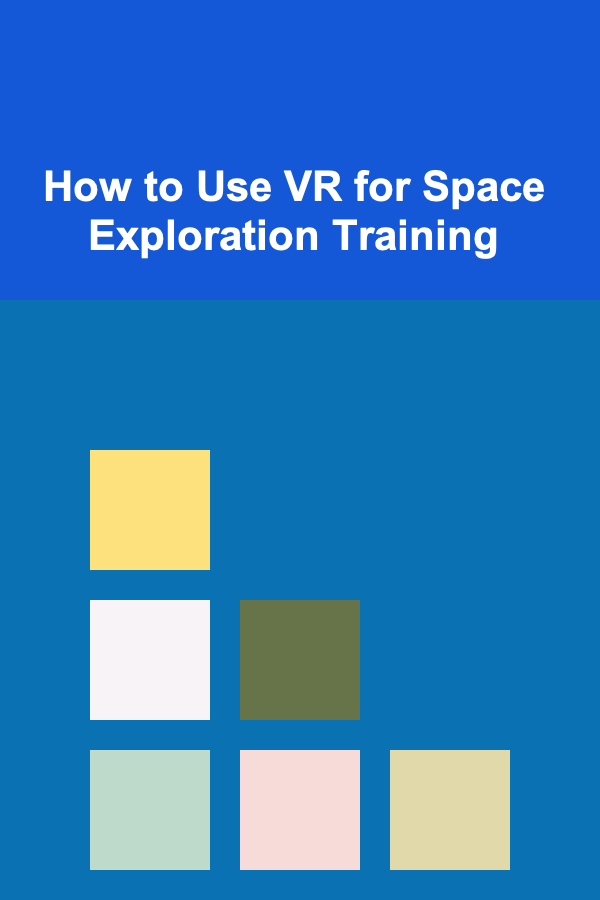
How to Use VR for Space Exploration Training
ebook include PDF & Audio bundle (Micro Guide)
$12.99$5.99
Limited Time Offer! Order within the next:

Virtual Reality (VR) has made remarkable strides in recent years, offering immersive experiences that simulate environments and activities that would otherwise be out of reach. One of the most exciting applications of VR is in space exploration training. With the complexities and risks involved in space missions, training astronauts requires precise, realistic, and efficient simulations. VR offers an ideal solution to these challenges, providing a safe, controlled, and adaptable environment for training.
In this article, we will explore how VR can be used for space exploration training, including its benefits, challenges, and real-world applications. We will look at the current state of VR in space training, how it enhances astronauts' skills, and its future potential in space missions.
The Need for Space Exploration Training
Space missions, whether crewed or unmanned, involve high-stakes operations that demand rigorous preparation. Astronauts need to learn how to navigate spacecraft, conduct scientific experiments, repair equipment, and handle emergency situations. These tasks often occur in extreme conditions, with limited resources and in an environment that is unlike anything on Earth.
Traditional space training methods include physical simulators, analog missions, and classroom education. However, these methods have limitations in terms of cost, accessibility, and the ability to replicate the exact conditions of space. VR, with its immersive capabilities, offers a solution by creating simulated environments that closely mirror real-world space scenarios. It allows astronauts to rehearse a wide range of activities, from spacewalks to operating robotic arms, without leaving Earth.
The Benefits of VR for Space Exploration Training
1. Immersive Experience
The most significant advantage of VR is its ability to provide an immersive experience. Astronauts can put on a VR headset and find themselves in a 360-degree simulation of outer space, a space station, or a rover on another planet. The realistic visuals and sounds, combined with haptic feedback, can replicate the sensation of zero gravity or the harsh conditions of a space mission.
2. Cost-Effectiveness
Training astronauts for space missions traditionally involves expensive simulations, travel to specialized facilities, and the use of costly physical equipment. With VR, space agencies can reduce costs significantly. VR training can be done on-site, at training centers, or even remotely, without needing the expensive infrastructure of full-scale simulators or real-life space analogs.
3. Safety and Risk Reduction
Space missions are inherently risky, and training astronauts in a high-risk environment is essential to ensure their safety. VR allows astronauts to experience hazardous situations, such as spacewalks in an uncontrolled environment, equipment malfunctions, or emergency evacuations, without the danger of real-life consequences. This kind of training enables astronauts to practice decision-making, problem-solving, and crisis management in a risk-free setting.
4. Customizable and Scalable Training
VR training modules can be customized to address specific mission requirements, such as training for Mars exploration, lunar missions, or space station operations. VR also allows for scalable training programs, where individual astronauts can train at their own pace and in different environments tailored to their needs. Additionally, VR can simulate a variety of situations and emergencies that might be too rare or dangerous to encounter during traditional training.
5. Immediate Feedback and Performance Tracking
One of the significant advantages of VR training is the ability to provide immediate feedback. During VR training, astronauts can receive real-time data on their performance, such as how accurately they performed a task or how efficiently they handled an emergency situation. This data can be used for evaluation, improvement, and further development of their skills. Additionally, trainers and mission controllers can monitor an astronaut's progress remotely and make adjustments as needed.
Types of VR Training for Space Exploration
1. Spacewalk Training
Spacewalks (extravehicular activities, or EVAs) are one of the most critical and dangerous tasks astronauts perform during a mission. These activities require precise movements, technical knowledge, and the ability to remain calm in an environment that is physically and psychologically demanding. VR can simulate spacewalks by recreating the conditions of outer space, such as microgravity, extreme temperatures, and the need for precise movement. Astronauts can practice using specialized tools, repairing spacecraft, or assembling equipment while floating in space.
2. Navigation and Control Systems Training
Operating spacecraft, space stations, or lunar rovers requires mastery of complex navigation and control systems. VR can provide astronauts with interactive training modules that simulate the operation of spacecraft systems, from docking procedures to troubleshooting on-board machinery. VR allows astronauts to practice these operations repeatedly, making them familiar with the controls, interface, and the necessary procedures in case of an emergency.
3. Emergency Protocols and Crisis Management
Emergencies in space can happen unexpectedly, whether it's a fire, cabin depressurization, or a malfunction in the spacecraft's life support system. VR can simulate various emergency scenarios, allowing astronauts to practice their responses and decision-making under stress. For instance, astronauts can rehearse evacuating a space station, fixing a malfunctioning air filtration system, or responding to a sudden equipment failure. By practicing these scenarios in VR, astronauts can prepare for the worst while minimizing the risk to their lives and mission.
4. Scientific Experimentation
Space missions often involve conducting scientific experiments, whether in a laboratory setting aboard the International Space Station (ISS) or on the surface of another planet. VR can be used to train astronauts on the various tools and techniques they will need for these experiments. For example, VR can simulate working with delicate equipment, handling biological samples in a zero-gravity environment, or conducting remote experiments from a rover on Mars. This type of training allows astronauts to familiarize themselves with the scientific instruments and procedures they will use in space, reducing the risk of errors during actual missions.
5. Physical Conditioning and Exercise
Astronauts spend extended periods in microgravity, which can have negative effects on their physical health, including muscle atrophy and bone density loss. VR can be integrated with physical training routines to simulate exercise in space. Using VR combined with motion capture technology, astronauts can perform physical exercises, such as resistance training or cardio workouts, in environments that mimic the conditions of space. This helps astronauts prepare physically for the challenges of living and working in space.
How VR Enhances Astronaut Training: Real-World Applications
NASA's VR Training Systems
NASA has been at the forefront of using VR for astronaut training. The agency developed the Virtual Reality Training System (VRTS), which provides a fully immersive environment where astronauts can practice spacewalks. The VRTS is used at NASA's Johnson Space Center, where astronauts train for various tasks that they may encounter in space, such as repairing the Hubble Space Telescope or conducting scientific experiments.
NASA also uses VR to simulate conditions on Mars and the Moon, giving astronauts a chance to experience what it would be like to operate a rover or perform experiments on these distant worlds. The use of VR in these training programs helps astronauts prepare for future missions, including the Artemis program, which aims to return humans to the Moon.
SpaceX and Virtual Training
SpaceX, another leader in the field of space exploration, is also leveraging VR technology for astronaut training. The company uses VR for mission simulations, allowing astronauts to practice every aspect of a mission, from launch and orbit to docking and re-entry. By simulating various flight scenarios, SpaceX can ensure that its astronauts are fully prepared for the complexities of space travel.
SpaceX's use of VR also extends to training astronauts for the company's commercial missions, where civilians will travel to space. These VR simulations help passengers become familiar with the spacecraft and its systems, making them feel more comfortable during the mission.
International Collaboration
Space agencies around the world are beginning to recognize the value of VR for space exploration training. The European Space Agency (ESA), the Russian space agency Roscosmos, and the Japan Aerospace Exploration Agency (JAXA) all use VR in different ways. For example, ESA uses VR for its astronauts to practice spacewalks and operate robotic arms, while JAXA employs VR simulations to train astronauts for missions to the ISS.
These collaborations are helping to create a shared VR training platform for space missions, improving the efficiency and consistency of training across different agencies. This global approach to VR training will be crucial as space missions become more complex and involve international partnerships.
Challenges and Limitations of VR for Space Training
While VR offers numerous benefits for space exploration training, it is not without its challenges. Some of the limitations of VR training include:
1. Technological Limitations
Despite the advancements in VR technology, creating highly realistic and immersive simulations still presents technical challenges. For example, accurately simulating microgravity, the sensation of weightlessness, and the extreme environmental conditions of space is difficult. The technology must constantly evolve to provide more detailed and precise simulations.
2. Motion Sickness
Some astronauts and trainees may experience motion sickness or discomfort when using VR headsets. This can hinder the effectiveness of training and limit the duration of training sessions. Designers are continually working to reduce this issue by improving VR hardware and ensuring smoother experiences.
3. Cost and Accessibility
Although VR can reduce the costs of traditional training, the initial setup for VR systems can be expensive. High-end VR equipment and specialized training environments require significant investment. Additionally, space agencies with limited budgets may struggle to implement widespread VR training programs.
4. Realism and Training Depth
While VR can simulate a wide range of scenarios, it may still fall short in replicating the full sensory experience of being in space. The lack of tactile feedback, the inability to simulate the complex effects of prolonged space travel on the human body, and the limited sensory inputs may affect how well astronauts prepare for real missions. Combining VR with other forms of training, such as physical simulators or analog missions, can help address these gaps.
The Future of VR in Space Exploration Training
The future of VR in space exploration training is incredibly promising. As VR technology continues to improve, it will become an even more integral part of astronaut training. Enhanced realism, better motion tracking, and improved hardware will allow astronauts to undergo more complex and effective training.
In addition, VR may play a crucial role in training for deep space missions, such as trips to Mars, where real-world training scenarios will be limited due to the long duration and distance of the mission. VR could simulate life on Mars or other celestial bodies, helping astronauts adapt to the challenges they will face during these groundbreaking missions.
Integration with Artificial Intelligence
The integration of AI with VR could further enhance training programs. AI can create dynamic training environments, where the system adapts to the astronaut's performance in real-time. For example, if an astronaut is struggling with a particular task, the AI could adjust the simulation to provide additional challenges or offer guidance. This personalized approach could significantly improve the learning experience and the astronaut's readiness for the mission.
Conclusion
Virtual Reality has the potential to revolutionize space exploration training, offering astronauts an immersive, cost-effective, and safe way to prepare for the complex challenges they will face in space. From spacewalks to emergency protocols, VR simulations provide astronauts with the opportunity to practice critical skills and make real-time decisions in a risk-free environment. While challenges remain, the continued development of VR technology and its integration with other training methods will ensure that astronauts are better prepared than ever before for the challenges of space exploration.

5 Ways to Create a Passive Income Stream with Deep Learning
Read More
How to Decorate Your Home Using Only Budget-Friendly Furniture
Read More
How to Maximize Small Spaces with Smart Decorating Choices
Read More
How to Organize Your Entryway Closet with Storage Solutions
Read More
How to Secure Your Home Without an Alarm System
Read More
How to Find and Retain Profitable Employees
Read MoreOther Products

5 Ways to Create a Passive Income Stream with Deep Learning
Read More
How to Decorate Your Home Using Only Budget-Friendly Furniture
Read More
How to Maximize Small Spaces with Smart Decorating Choices
Read More
How to Organize Your Entryway Closet with Storage Solutions
Read More
How to Secure Your Home Without an Alarm System
Read More